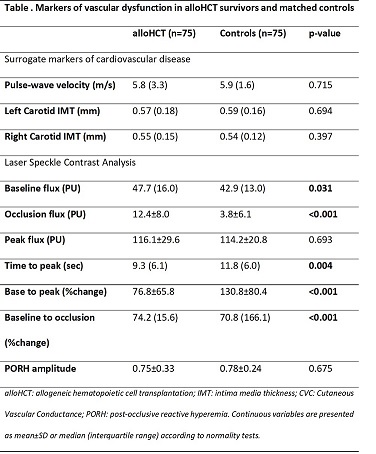
Contributions
Abstract: EP1232
Type: E-Poster Presentation
Session title: Stem cell transplantation - Clinical
Background
Allogeneic hematopoietic cell transplantation (alloHCT) survivors have been recently recognized as patients at increased cardiovascular risk. Although impaired microcirculation dynamics are currently considered an important component of the pathophysiology of CV disease, their role has not been studied in alloHCT.
Aims
We hypothesized that microcirculation dynamics are impaired in alloHCT, independently of traditional cardiovascular risk factors.
Methods
We enrolled consecutive adult alloHCT survivors and otherwise healthy control individuals (January 2019-March 2020), matched for traditional cardiovascular risk factors. Microvascular dysfunction was dynamically assessed by Laser Speckle Contrast Analysis (LASCA); pulse-wave velocity (PWV) and intima media thickness (IMT) were assessed as surrogate markers of cardiovascular disease.
Results
We studied 75 alloHCT survivors after a median of 3.2 (range 2.1-4.9) years from alloHCT, who had suffered from grade 2-3 acute (20%) and/or moderate/severe chronic GVHD (42%), and 75 controls. Although traditional cardiovascular risk factors and surrogate markers of cardiovascular disease did not differ between groups, alloHCT survivors showed significantly impaired microvascular response (Table). Among them, occlusion flux and baseline to occlusion change independently predicted alloHCT status in the multivariate model.
Baseline, occlusion, time to peak, and base to peak change were also significantly impaired in patients with a hypertension diagnosis. Baseline flux was associated with age (r2=0.191, p=0.020), office DBP (r2=0.225, p=0.009), and PWV (r2=0.034, p=0.050). Time to peak had an association with BMI (r2=-0.189, p=0.034), office systolic BP (r2=-0.186, p=0.038), heart rate (r2=-0.375, p<0.001), and PWV (r2=-0.314, p=0.014). Baseline to occlusion change was associated with office DBP (r2=0.225, p=0.009), and PWV (r2=0.335, p=0.001). Baseline to peak change was associated only with office DBP (r2=-0.299, p=0.009). No significant associations were observed in LASCA indices and studied transplant characteristics.
Taking into account the univariate associations of LASCA indices, we further performed multivariate analyses to determine independent predictors. Only factors with significant univariate associations with the dependent variable were included in the multivariate model. The only independent predictor of baseline flux and baseline to occlusion change was the history of alloHCT (p=0.002 and p=0.022 respectively). Regarding time to peak change, heart rate and history of alloHCT independently predicted time to peak change in the multivariate model (p=0.044 and p=0.037 respectively).

Conclusion
Our study shows for the first time impaired indices of dynamic microcirculation assessment in adult alloHCT survivors, as this is reflected by LASCA, independently of traditional CV risk factors. Furthermore, we were able to identify occlusion flux and baseline to occlusion change as the most significant predictors. Lastly, our findings confirm that patients with hypertension are at higher risk of microvascular dysfunction. Additional studies are needed to address the role of novel markers in cardiovascular risk prediction, as well as the effects of disease type, phase, and pre-transplant treatments.
Keyword(s): Allogeneic hematopoietic stem cell transplant, Graft-versus-host disease (GVHD), Late effects
Abstract: EP1232
Type: E-Poster Presentation
Session title: Stem cell transplantation - Clinical
Background
Allogeneic hematopoietic cell transplantation (alloHCT) survivors have been recently recognized as patients at increased cardiovascular risk. Although impaired microcirculation dynamics are currently considered an important component of the pathophysiology of CV disease, their role has not been studied in alloHCT.
Aims
We hypothesized that microcirculation dynamics are impaired in alloHCT, independently of traditional cardiovascular risk factors.
Methods
We enrolled consecutive adult alloHCT survivors and otherwise healthy control individuals (January 2019-March 2020), matched for traditional cardiovascular risk factors. Microvascular dysfunction was dynamically assessed by Laser Speckle Contrast Analysis (LASCA); pulse-wave velocity (PWV) and intima media thickness (IMT) were assessed as surrogate markers of cardiovascular disease.
Results
We studied 75 alloHCT survivors after a median of 3.2 (range 2.1-4.9) years from alloHCT, who had suffered from grade 2-3 acute (20%) and/or moderate/severe chronic GVHD (42%), and 75 controls. Although traditional cardiovascular risk factors and surrogate markers of cardiovascular disease did not differ between groups, alloHCT survivors showed significantly impaired microvascular response (Table). Among them, occlusion flux and baseline to occlusion change independently predicted alloHCT status in the multivariate model.
Baseline, occlusion, time to peak, and base to peak change were also significantly impaired in patients with a hypertension diagnosis. Baseline flux was associated with age (r2=0.191, p=0.020), office DBP (r2=0.225, p=0.009), and PWV (r2=0.034, p=0.050). Time to peak had an association with BMI (r2=-0.189, p=0.034), office systolic BP (r2=-0.186, p=0.038), heart rate (r2=-0.375, p<0.001), and PWV (r2=-0.314, p=0.014). Baseline to occlusion change was associated with office DBP (r2=0.225, p=0.009), and PWV (r2=0.335, p=0.001). Baseline to peak change was associated only with office DBP (r2=-0.299, p=0.009). No significant associations were observed in LASCA indices and studied transplant characteristics.
Taking into account the univariate associations of LASCA indices, we further performed multivariate analyses to determine independent predictors. Only factors with significant univariate associations with the dependent variable were included in the multivariate model. The only independent predictor of baseline flux and baseline to occlusion change was the history of alloHCT (p=0.002 and p=0.022 respectively). Regarding time to peak change, heart rate and history of alloHCT independently predicted time to peak change in the multivariate model (p=0.044 and p=0.037 respectively).

Conclusion
Our study shows for the first time impaired indices of dynamic microcirculation assessment in adult alloHCT survivors, as this is reflected by LASCA, independently of traditional CV risk factors. Furthermore, we were able to identify occlusion flux and baseline to occlusion change as the most significant predictors. Lastly, our findings confirm that patients with hypertension are at higher risk of microvascular dysfunction. Additional studies are needed to address the role of novel markers in cardiovascular risk prediction, as well as the effects of disease type, phase, and pre-transplant treatments.
Keyword(s): Allogeneic hematopoietic stem cell transplant, Graft-versus-host disease (GVHD), Late effects


